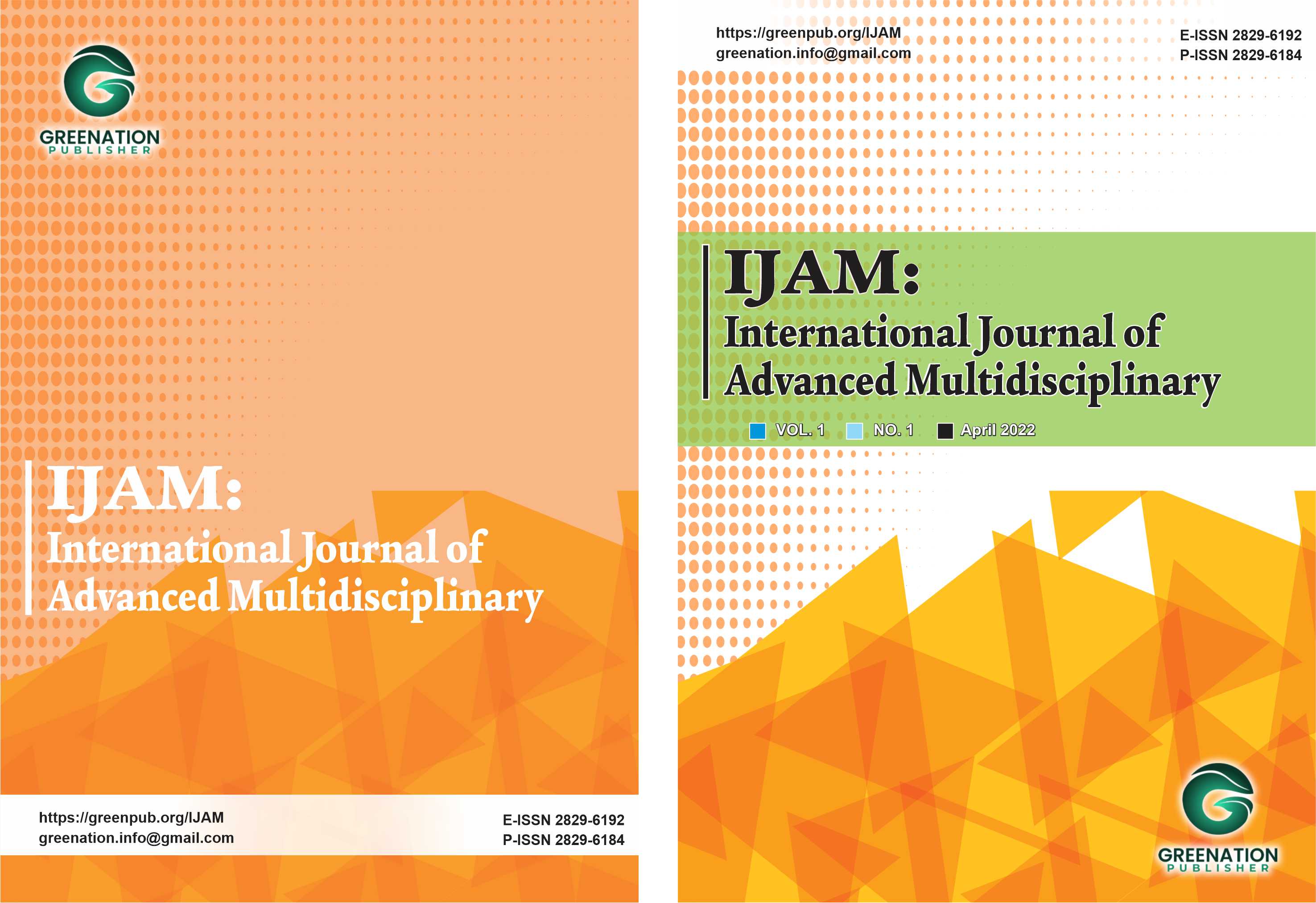Supply Chain Management: Survey Consumer Preferences and Market Potential (Study Literature Review)
DOI:
https://doi.org/10.38035/ijam.v3i1.508Keywords:
Supply Chain Management, Survey Consumer Preferences, Market PotentialAbstract
The supply chain management article: survey of consumer preferences and market potential is a scientific literature review article within the scope of operational management science. This article aims to create a hypothesis regarding the relationship between factors, which can subsequently be utilized for future research in the field of human resource management. Descriptive qualitative research methodology was employed in this study. The data utilized in this study was derived from prior research that remains pertinent to the current investigation. The data was gathered from reputable academic online platforms, including Publish or Perish, Google Scholar, digital reference books, and Sinta journals. The findings of this study are as follows: 1) Consumer preference surveys play a role in supply chain management: Surveys offer significant insights into consumer preferences, wants, and expectations pertaining to a specific product or service. These insights serve as the foundation for organizations in formulating marketing strategies, developing products, and managing inventory. By gaining a comprehensive grasp of consumer preferences, organizations have the potential to enhance customer happiness, streamline their supply chains, and attain a competitive edge in marketplaces that are becoming progressively intricate and dynamic; and 2) Market potential plays a role in supply chain management: market potential offers a comprehensive overview of the current market size, potential for growth, and consumer patterns in a specific region or demography. This data enables organizations to develop supply chain strategies that are characterized by enhanced efficiency and adaptability in response to dynamic market needs. Through a comprehensive comprehension of market potential, organizations are able to effectively identify prospective market segments, formulate suitable expansion strategies, and adapt their supply chain approaches in order to maximize profitability and foster corporate expansion.
References
Ali, H., & Limakrisna, N. (2013). Metodologi Penelitian (Petunjuk Praktis Untuk Pemecahan Masalah Bisnis, Penyusunan Skripsi (Doctoral dissertation, Tesis, dan Disertasi. In In Deeppublish: Yogyakarta.
Aslam, H., Waseem, M., Roubaud, D., Grebinevych, O., Ali, Z., & Muneeb, D. (2023). Customer integration in the supply chain: the role of market orientation and supply chain strategy in the age of digital revolution. Annals of Operations Research. https://doi.org/10.1007/s10479-023-05191-y
Azzahra, A. H., Hidayat, Y. R., & Budirokhman, D. (2023). ANALISIS KEPUASAN KONSUMEN PADA RANTAI PASOK PANGAN PENDEK PRODUK SAYUR SEGAR DI KABUPATEN CIREBON. Jurnal Viabel Pertanian, 17(2), 81–90.
Bednarski, L., Roscoe, S., Blome, C., & Schleper, M. C. (2023). Geopolitical disruptions in global supply chains: a state-of-the-art literature review. Production Planning and Control, 0(0), 1–27. https://doi.org/10.1080/09537287.2023.2286283
Bijakwani, I. A. (2018). PENGARUH ORIENTASI PASAR TERHADAP KINERJA PERUSAHAAN DENGAN STRATEGI MANAJEMEN RANTAI PASOKAN SEBAGAI VARIABEL MEDIASI (Studi Pada UKM Di Kabupaten Sleman).
Desfiandi, A., Yusendra, M. A. E., Paramitasari, N., & Ali, H. (2019). Supply chain strategy development for business and technological institution in developing start-up based on creative economy. International Journal of Supply Chain Management.
Fuadi, D. S., Akhyadi, A. S., & Saripah, I. (2021). Systematic Review: Strategi Pemberdayaan Pelaku UMKM Menuju Ekonomi Digital Melalui Aksi Sosial. Diklus: Jurnal Pendidikan Luar Sekolah, 5(1), 1–13. https://doi.org/10.21831/diklus.v5i1.37122
Ginny, P. L. (2019). Analisis Strategi Bersaing Perusahaan Yang Bergerak Dibidang Logistik di Jakarta. PRIMANOMICS: Jurnal Ekonomi Dan Bisnis, 17(2).
Hakim, M. H., & Saputro, A. R. (2023). Motivasi, Persepsi Dan Preferensi Konsumen Terhadap Rantai Pasok Halal. Journal of Manufacturing in Industrial Engineering & Technology, 1(1), 52–57. https://doi.org/10.30651/mine-tech.v1i1.16639
Harini, S., Hamidah, Luddin, M. R., & Ali, H. (2020). Analysis supply chain management factors of lecturer’s turnover phenomenon. International Journal of Supply Chain Management.
Ilham, Eliyana, A., Rizki Sridadi, A., Usman, I., & Purnomo, A. (2021). Effect Implementation of Information Technology Software on Improving Performance Capacity Academic and Non Academic Service Sunan Ampel Islamic University of Surabaya. Journal of Physics: Conference Series, 1779(1). https://doi.org/10.1088/1742-6596/1779/1/012052
Maulita, M. (2022). Pengaruh Tekanan Regulasi Terhadap Inovasi Teknologi Hijau Dan Kinerja Ekonomi Pada Industri Pelayaran Di Samarinda. Sebatik, 26(2), 710–717. https://doi.org/10.46984/sebatik.v26i2.2028
Müller, M. (2023). The ‘new geopolitics’ of mineral supply chains: A window of opportunity for African countries. South African Journal of International Affairs, 30(2), 177–203. https://doi.org/10.1080/10220461.2023.2226108
Mulyani, I., Zamzami, E. M., & Zendrato, N. (2019). Pengaruh Sistem Teknologi Informasi Pada Manajemen Data Dan Informasi Dalam Layanan Keperawatan: Literature Review. Inspiration: Jurnal Teknologi Informasi Dan Komunikasi, 9(2), 137–142. https://doi.org/10.35585/inspir.v9i2.2526
Mutia Ardini, Cut Gustiana, S. A. (2022). ANALISIS PENGARUH PREFERENSI KONSUMEN TERHADAP KEPUTUSAN PEMBELIAN IKAN BANDENG (Chanos chanos) DI KECAMATAN SERUWAY KABUPATEN ACEH TAMIANG. Jurnal Inovasi Penelitian, 2(11), 3765–3772.
Nashr, F., Putri, E. I. K., Dharmawan, A. H., & Akhmad, F. (2022). Determinan Keberlanjutan Petani Sawit Swadaya dalam Rantai Pasok Multi-Jenjang. Tataloka, 24(2), 101–115. https://doi.org/10.14710/tataloka.24.2.101-115
Nasrullahi, M., Sulistyaningsih, S., & Puryantoro, P. (2024). ANALISIS PREFERENSI KONSUMEN TERHADAP PRODUK ABON IKAN BANDENG (Chanos Chanos) DI UMKM D’PORE MEME DESA ALASMALANG KECAMATAN PANARUKAN KABUPATEN SITUBONDO. AGRIBIOS: Jurnal Ilmiah.
Nofrialdi, R., Saputra, E. B., & Saputra, F. (2023). Pengaruh Internet of Things: Analisis Efektivitas Kerja , Perilaku Individu dan Supply Chain. Jurnal Manajemen Dan Pemasaran Digital (JMPD), 1(1), 1–13. https://dinastires.org/JPKN/article/view/111/104
Pasaribu, R., Manurung, A. H., Rony, Z. T., Bhayangkara, U., Raya, J., Bhayangkara, U., Raya, J., Bhayangkara, U., & Raya, J. (2022). THE EFFECT OF LEADERSHIP , EMPLOYEE PERFORMANCE , MOTIVATION AND INFORMATION TECHNOLOGY ON EMPLOYEE JOB SATISFACTION MODERATED BY AGE OF EMPLOYEES AT DINAS PENANAMAN MODAL DAN PELAYANAN TERPADU SATU. Dinasti International Journal of Management Science, 3(3), 592–602.
Prabowo, I., & Nasito, M. (2023). Pengaruh Manajemen Rantai Pasokan Terhadap Kinerja Operasional pada SRC (Sampoerna Retail Community). Jurnal Ilmiah Multidisiplin, 1(6), 541–553. https://doi.org/10.5281/zenodo.8135950
Prayetno, S., & Ali, H. (2020). Entrepreneurial supply chain management competence: Predictors of work motivation advocate. International Journal of Supply Chain Management, 9(3), 444–454.
Qin, M., Su, C.-W., Umar, M., Lobon?, O.-R., & Manta, A. G. (2023). Are climate and geopolitics the challenges to sustainable development? Novel evidence from the global supply chain. Economic Analysis and Policy, 77, 748–763.
Sulaeman, A. S., Waluyo, B., & Ali, H. (2019). Making dual procurement and supply chain operations: Cases in the indonesian higher education. International Journal of Supply Chain Management.
Sundari, C. (2019). Revolusi Industri 4.0 Merupakan Peluang Dan Tantangan Bisnis Bagi Generasi Milenial Di Indonesia. Prosiding SEMINAR NASIONAL DAN CALL FOR PAPERS, Fintech dan E-Commerce untuk Mendorong Pertumbuhan UMKM dan Industri Kreatif, 555–563.
Tri Murti, H., Puspita, V., & Ratih, P. (2021). Pemanfaatan Teknologi Informasi dan Manajemen Perubahan Organisasi dalam Mendukung Bisnis Berkelanjutan Pasca Covid-19 pada UMKM di Kota Bengkulu. Jurnal Bisnis Dan Pemasaran Digital (JBPD), 1(1), 33–41.
Trieu, H. D. X., Nguyen, P. Van, Nguyen, T. T. M., Vu, H. T. M., & Tran, K. T. (2023). Information technology capabilities and organizational ambidexterity facilitating organizational resilience and firm performance of SMEs. Asia Pacific Management Review, 28(4), 544–555. https://doi.org/10.1016/j.apmrv.2023.03.004
Vass, T. de, Shee, H., & Miah, S. (2018). The effect of “Internet of Things” on supply chain integration and performance: An organisational capability perspective. Academy of Management Proceedings, 22(1), 1–29. https://doi.org/10.5465/ambpp.2018.18643abstract
Wardhani, W., Sumarwan, U., & Yuliati, L. N. (2016). Pengaruh Persepsi dan Preferensi Konsumen terhadap Keputusan Pembelian Hunian Green Product. Jurnal Manajemen Dan Organisasi, 6(1), 45. https://doi.org/10.29244/jmo.v6i1.12183
Wibowo, A. H. E., & Hakiki, R. (2022). Analisis Swot Dalam Strategi Pemasaran Untuk Meningkatkan Penjualan Alfa Hidrofarm Di Desa Ciawi Kecamatan Ciawi Kabupaten Tasikmalaya. EQUILIBIRIA: Jurnal Fakultas Ekonomi, 9(2), 262–267. https://doi.org/10.33373/jeq.v9i2.4829
Widjanarko, W., Hadita, H., Saputra, F., & Cahyanto, Y. A. D. (2023). Determinasi Kemudahan Akses Informasi Bagi Keputusan Investasi Gen Z. Digital Bisnis: Jurnal Publikasi Ilmu Manajemen Dan E-Commerce, 2(4), 248–264.
Downloads
Published
How to Cite
Issue
Section
License
Copyright (c) 2024 Primadi Candra Susanto, Euis Saribanon, Yosi Pahala, Esti Liana, Harry Purwoko

This work is licensed under a Creative Commons Attribution 4.0 International License.
Authors who publish their manuscripts in this journal agree to the following conditions:
- The copyright on each article belongs to the author(s).
- The author acknowledges that the International Journal of Advanced Multidisciplinary (IJAM) has the right to be the first to publish with a Creative Commons Attribution 4.0 International license (Attribution 4.0 International (CC BY 4.0).
- Authors can submit articles separately, arrange for the non-exclusive distribution of manuscripts that have been published in this journal into other versions (e.g., sent to the author's institutional repository, publication into books, etc.), by acknowledging that the manuscript has been published for the first time in the International Journal of Advanced Multidisciplinary (IJAM).























